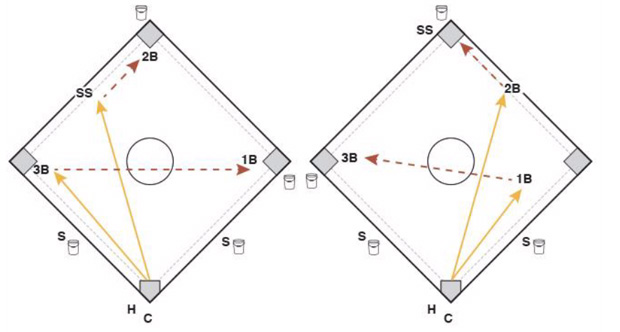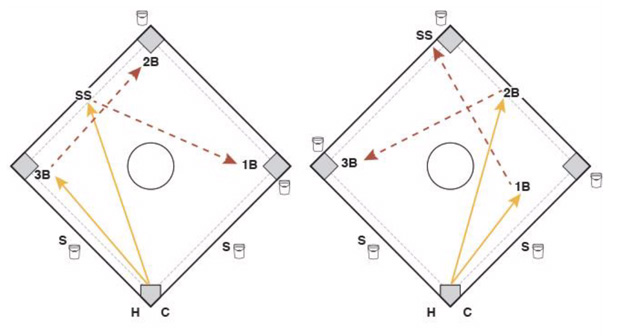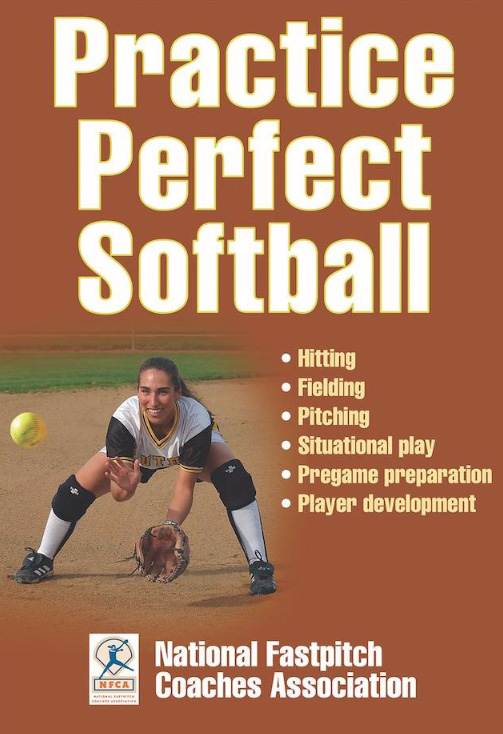| Organize Effective, Time-Efficient Softball Fielding Drills |
| By: National Fastpitch Coaches Association
Provided by: STACK Skill Practice Divide the gym in half and use half for bunting and slapping practice and the other half for fielding practice. Side A-Outfielders and Pitchers Practice Bunting and Slapping Four players bunt for a hit off a machine without defense. The rest of the players shag and return balls to the person at the machine. The players bunting get one pitch for a bunt on the run. The players do this quickly so they get the idea to be ready to run out of the bunt. Setup The person feeding the machine puts a ball in as quickly as possible and continues to feed the machine at a steady pace. Obviously, the feeder has to adapt the speed to the ability of the players who are bunting but soon comes to a good rhythm. Execution The first player bunts on the run, runs 5 to 10 steps, and then goes to the end of the line. The second player bunts immediately after the first player and so on. Coaching Points • The player should transfer her weight to the front foot when starting her run. The back foot is off the ground on contact. • The hands on the bat are split so that they are stronger when contacting the ball. The wrist on the bottom hand should be pointed down to make it stronger. The top hand should grip the bat with at least three fingers and the thumb. • Using fewer fingers makes the hand weaker. When either hand is in a weak position, the player is at higher risk of fouling the ball off against faster pitches. • The bat should be level and at eye level away from the body. • The ball is contacted out in front of the body, and the top hand acts as a pivot point. If the player pushes her bottom hand straight out, the ball goes toward first if the batter is right-handed and toward third if the player is left-handed. If the bottom hand is pulled in as far as possible, the ball off a right-handed batter will go toward third and the ball off a lefty will go toward first. • When a lefty wants to do a drag bunt toward first, it is easier to use just the top hand and take the bottom hand off the bat. In this case, the bat needs to be in the high strike area, parallel to the ground. The bottom of the bat and knob should be against the player's forearm for stability. • After all balls have been used-ideally after at least two buckets of balls-switch to four new players. Each group should practice bunting a couple of times if possible. Variations • When all players have bunted numerous times, add a defense. The drill will go slower because the defenders are throwing the ball to first. • Do the same drill but switch to slapping. • Do slapping against a defense. Side B-Infielders and Catchers Do Infield Practice Drill 1 Setup Maximize the number of repetitions for each player by alternating hits to third base and shortstop and having the third baseman throw to first and the shortstop throw to second. Execution • The players receiving the throws can either put the ball in a bucket or toss it to a specific shagger. The hitter put balls in play quickly, hitting to the shortstop as the first fielder is throwing and doing this numerous times (figure 8.5a). • The hitter switches to hitting to the second baseman, who throws to third and to the first baseman, who throws to the shortstop covering second. The hitter needs to pay attention to where the players are so that no one is in a throwing lane. Repeat until all players have had their workouts (figure 8.5b).
Drill 2 Players field various types of hits. Execution The coach hits to the infielders, hitting hard grounders, soft grounders, line drives, balls over the head, bunts, short hops, backhand shots, hits up the middle, hits in the gaps, hits down the lines, foul-ball pop-ups, foul-ball line drives, and balls that require players to throw on the run. Coaching Points For some of these kinds of hits, throwing the ball to the desired area is easier than hitting the ball with a bat. Too much time is wasted trying to hit the ball in shallow areas like just over first or third, so just throw it there for better accuracy. Keeping the practice moving is extremely important for keeping the players involved mentally. • The hitter switches to hitting to the third baseman, who now throws to second and to the shortstop, who now throws to first. • The hitter switches to hitting to the second baseman, who now throws to the shortstop covering second and to the first baseman, who throws to third. Players switch to the other side of the gym. For side 2A, infielders and catchers do the slap and bunt drills described earlier. For side 2B, outfielders practice fielding (because the gym probably has a low ceiling, high fly ball drills have to be outside). Drill 3 Outfielders and pitchers work on line drives, bloops, two-person tweeners, foul balls, grounders, and throwing to the various bases. Emphasis should be placed on getting the ball to the infielders quickly and accurately. Situational Practice Open the curtain that divides the room and bring the team back together for a situational practice. While working on situational plays, practicing with pressure is extremely important to simulate game situations. Drill 1 Infielders work on grounders and situations. Outfielders, extra pitchers and catchers are runners. Tell the runners to be aggressive but smart. This drill puts pressure on the fielders and gives them a better idea of how quickly they need to be to get the out. They also need to think ahead and be ready for the second and third plays. You can hit the ball anywhere at any time to cover all situations. You can hit singles, doubles, and balls that ricochet off the walls. A runner should purposely get into a rundown when you call it. Put runners on bases to work on various situations. This drill is also helpful for the runners. By trying to push the infielders, they learn when to stay, when to go, when to take an extra base, and how to be aggressive. Drill 2 Outfielders work on line drives, bloops, balls down the line, balls off the fence (wall), tweeners, and so on. Infielders, extra catchers, and pitchers run the bases. Extra outfielders take their throws at the bases and home. Runners work on being aggressive, breaking off the bases to draw throws, and tagging up and advancing to the next base. Put runners on base to work on situations. To take it a step further, when the ball is thrown to the catcher to get a runner, she can then throw the ball to another base, simulating the batter or baserunner taking an extra base. From there, the ball can be thrown to other bases as well. For example, the ball goes to the catcher, she make a tag and throws to second. The player there makes a tag and throws to third, and the third baseman makes a tag and throws home. After the initial throw to the catcher, the runners are imaginary, but the fielders get to practice thinking ahead, making a tag, pivoting, and going quickly to the next play. Having players practice numerous skills in the same drill is beneficial. More players are involved, and the players have to go on to the next play, work on a tag play, and quickly go on to the next play. Call out the base to go to next, and the players have to react. Finish the practice with a short game with a pitcher. Put runners on base for situations. Work on steals, delay steals, squeezes, and breaking off bases to put pressure on the defense, including the pitcher and catcher. All players need encouragement and positive feedback, but they also need direction and discipline. The best way to have effective learning at practices is to be organized, positive, and definite in the way you give directions. Self-assured, confident instruction lets the players know that the coaching is strong. They will follow.
Excerpted from Practice Perfect Softball, by the National Fastpitch Coaches Association. ©2016. Reprinted with permission from Human Kinetics. All rights reserved. No reproduction, transmission, or display is permitted without the written permission of Human Kinetics, Inc |










